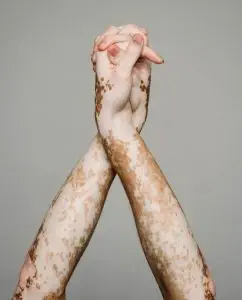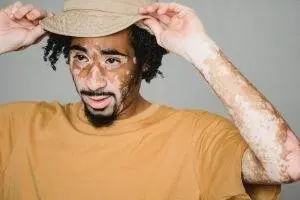by Qineng Tan, L.Ac., Ph.D. and Xiaomei Cai, L.Ac., Ph.D.

White patches on skin, white spots on face? Graying hair? White patches of skin can be a sign of Vitiligo. Vitiligo is a chronic autoimmune disease that affects the melanin, or pigment, in the skin. Acupuncture and TCM offer a holistic, complementary vitiligo treatment that can help with repigmentation.
Vitiligo occurs when the pigmentation of your skin changes, with white patches on face or other parts of the body. This usually happens because of an autoimmune disorder that affects the cells that create pigment in the skin, hair, and eyes.
Vitiligo can show up in different ways. Possible signs of vitiligo include:
- Lighter patches of skin on face, arms, hands, and/or feet, white patches on skin
- Patches can be pink, tan, or white
- Loss of pigmentation on lips and/or inside mouth
- Loss of pigmentation on or inside the nose
- White patches of skin are itchy sometimes, usually when they are spreading
- Premature graying hair, hair turning gray
- A streak of white hair on scalp develops
- Eyelashes turn white, or eyebrows turn white
- Eye color changes, may affect eyesight
- Inner ear problems, can lead to hearing loss
- Anxiety and depression due to changes in appearance
While vitiligo is not considered harmful, these changes in outward appearance can have a serious impact on the way a person feels about themselves. Vitiligo disease treatment with acupuncture and TCM can help not only with repigmentation, but can help address the underlying causes of autoimmune disease, and mental health concerns, all at the same time.
What Causes Vitiligo?
White patches on skin happen when cells called melanocytes, which produce pigment, either stop functioning correctly or die.
Medical research has not yet determined exactly why some people get vitiligo, but it is generally considered to occur because of an autoimmune condition. When a person has an autoimmune disorder, their immune system mistakenly attacks certain cells in the body. In the case of vitiligo, the immune system attacks the melanocytes.
Some people notice that their vitiligo starts developing after getting a particularly bad sunburn. A regular burn, or exposure to caustic chemicals can trigger the development of vitiligo, as can a bad cut or scrape.
Stress can trigger vitiligo, or make it worse. Both physical stress and emotional stress may often precede either the initial onset of vitiligo, or accelerate the spread of patches of vitiligo on the skin.
Risk factors for Vitiligo

People of all ages and ethnicities can have vitiligo. In about half of cases, vitiligo begins to appear in childhood or before the age of 20.
If other people in your family have vitiligo, or other autoimmune diseases, then there is a greater chance that you will have it.
People who have other autoimmune disorders may have a higher risk of experiencing vitiligo. These autoimmune conditions include:
- Lupus
- Hyperthyroidism
- Hashimoto’s disease
- Graves disease
- Psoriasis
- Rheumatoid arthritis
- Type 1 Diabetes
- Anemia
- Addison’s disease
Having a specific type of moles on your skin called halo nevi can increase your risk for vitiligo. Those are moles that have a white ring, or “halo,” around them.
Having melanoma or non-Hodgkin lymphoma can also increase your risk for vitiligo, as can going through immunotherapy for melanoma.
Even though vitiligo is not considered dangerous, it is important to seek out a proper diagnosis and treatment, because having one autoimmune condition can sometimes lead to developing other autoimmune diseases.
Types of Vitiligo
Vitiligo will develop differently for each individual. Different kinds of vitiligo are categorized according to where they appear. Types of vitiligo include:
- Generalized vitiligo: most common type, causes macules to appear in various places on the body
- Segmental vitiligo: only affects one side of your body or one area, such as the face or hands.
- Mucosal vitiligo: affects the mucous membranes of mouth and/or genitals
- Focal vitiligo: rare type where the macules develop in a small area
- Trichrome vitiligo: shows up as a bullseye shape with a white center, a lighter area, and an area of natural skin tone.
- Universal vitiligo: rare condition that causes more than 80% of skin to not have pigment
Vitiligo Treatment
A doctor will diagnose vitiligo by taking a family history, testing for other autoimmune diseases, checking the skin with a black light, which will make the patches easier to detect, and probably taking a small skin biopsy to check for melanocytes, or lack thereof.
The main aim of conventional vitiligo disease treatment is to slow the spread of the condition, and hopefully to help the skin regain its pigment by helping to encourage the growth of melanocytes.
Immunosuppressant medications can help to slow or halt the spread of vitiligo. Calcineurin inhibitors are a specific type of immunosuppressants that may be prescribed for vitiligo, as well as for other autoimmune disease rash, such as lupus rash.
However, this type of vitiligo treatment requires continued use; when people stop taking the medications, the condition will usually come back and continue to spread.
There are various types of vitiligo therapy that may help skin regain its normal pigmentation. These include:
- Light therapy
- Topical steroid creams
Some dermatology specialists perform surgical procedures to help with repigmentation, but these are not recommended if the condition is still spreading, or if a person tends to develop scarring.

About 50% of vitiligo cases begin in childhood or adolescence. Vitiligo can be particularly difficult and even traumatic for young people. While the treatment methods are similar for children with vitiligo (corticosteroids, phototherapy, and/or immunosuppressants), it is especially important that young patients also receive emotional and mental health support during treatment.
While medical vitiligo therapies help in some cases, other people may not see much improvement. None of these treatments address the root cause of vitiligo. Acupuncture and TCM help by working on several levels, to help restore normal functioning of the immune system, help with repigmentation of the white patches of skin, and to help address issues like anxiety and depression, as well.
Can Acupuncture Help Vitiligo?
Traditional Chinese Medicine (TCM) has been used to treat vitiligo for centuries. TCM treatment for vitiligo was first mentioned in the medical text, The Yellow Emperor’s Classic of Internal Medicine, over 2500 years ago.
In TCM, vitiligo is referred to as “Bai Dian Feng,” which means something akin to “white patches wind.” In TCM, many skin and immune conditions are considered to be related to wind as a pathogenic force that moves through the body.
The development of this autoimmune condition that affects the skin’s appearance can occur due to a particular imbalance, or a combination of factors. Some of the TCM diagnostic patterns that pertain to vitiligo include:
- Liver wind with Kidney deficiency
- Spleen and Stomach deficiency
- Qi and Blood deficiency and/or stasis
- Too much internal heat
Depending on accompanying symptoms, your acupuncturist will observe which organ systems need nourishing and/or clearing, and will tailor a treatment plan for each individual case. A combination of acupuncture treatment and herbal supplements will be recommended to help address your condition.
Acupuncture needles, applied to specific points, can help to improve circulation and blood flow to areas of the skin and activate cells to help restore natural skin color. Other points will be chosen to help move Qi and strengthen the liver and kidneys, as well as reducing overall inflammation and boosting immune function.
Topical herb creams made from traditional Chinese herbal remedies can be effective for helping to stimulate melanin production. Chinese herb formulas designed to be taken internally as a tea will work to nourish the liver and kidneys, dispel wind and clear heat.
Acupuncture Near Me for Vitiligo
Acupuncture and herbs can be used either as an alternative or adjunct treatment for vitiligo. TCM treatment will also work for vitiligo in children, and can be particularly helpful as a gentle modality that does not cause unwanted side effects.
Drs. Tan and Cai at Art of Wellness Acupuncture in West L.A. have over 35 years of experience working with patients with autoimmune skin conditions of all kinds. Art of Wellness was recently named one of the best acupuncture providers in Los Angeles. If you or someone you know is suffering with vitiligo, please do not hesitate to contact us.
*This article is for education from the perspective of Traditional Chinese Medicine only. The education provided by this article is not approved by FDA to diagnose, prevent, treat and cure human diseases. It should not stop you from consulting with your physician for your medical conditions. Traditional Chinese Medicine is based on Qi, which is an invisible force that usually cannot be observed by modern science. Because science focuses on testing ideas about the natural world with evidence obtained through observation, these aspects of acupuncture can’t be studied by science. Therefore acupuncture and Chinese herbs are often not supported by double-blind, randomized trials, and they are considered alternative medicine therapies in the United States.
